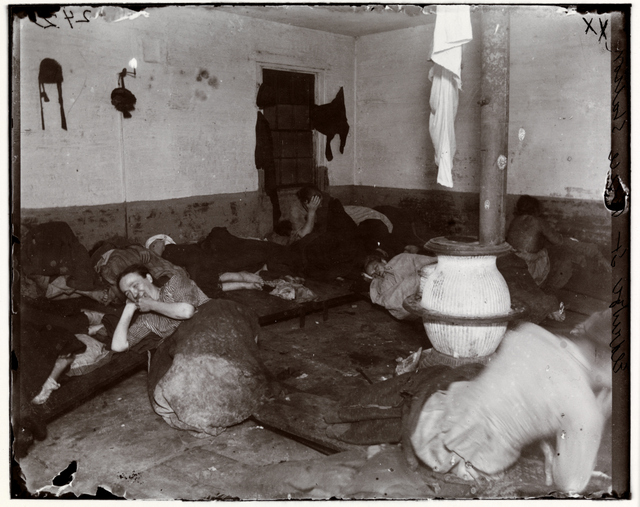2. The Eldridge Street Police Station
 Photo by Jacob A. Riis, Museum of the City of New York Collection
Photo by Jacob A. Riis, Museum of the City of New York Collection
Pictured above is a typhus lodger, lying on the floor by the stove of the police station lodging house on Eldridge Street. Lodging house types ran the gamut and Riis describes the options in How The Other Half Lives:
There are no licensed lodging-houses known to me which charge less than seven cents for even such a bed as this canvas strip, though there are unlicensed ones enough where one may sleep on the floor for five cents a spot, or squat in a sheltered hallway for three. The police station lodging-house, where the soft side of a plank is the regulation couch, is next in order. The manner in which this police bed is “made up” is interesting in its simplicity. The loose planks that make the platform are simply turned over, and the job is done, with an occasional coat of whitewash thrown in to sweeten things.
 Women lodgers at Eldridge Street Station circa 1890. Photo by Jacob A. Riis, Museum of the City of New York Collection
Women lodgers at Eldridge Street Station circa 1890. Photo by Jacob A. Riis, Museum of the City of New York Collection
Above is a photograph of the women’s room of the police station lodging house on Eldridge Street, where they slept on plank beds and the floor. The 1886 Municipal Lodging House act gave the city ability to operate homeless shelters but these were not open to “women, children, the elderly or the infirm” who sought refuge in police stations and other locations.
As exhibit curator Bonnie Yochelson writes in the book Rediscovering Jacob Riis: Exposure Journalism and Photography in Turn-of-the-Century New York, Riis’ photographs inside New York City’s police station lodging houses represent “his most extensive documentation of a single subject,” spurred by Riis’ own horrifying experience inside one himself shortly after arriving to the United States.





